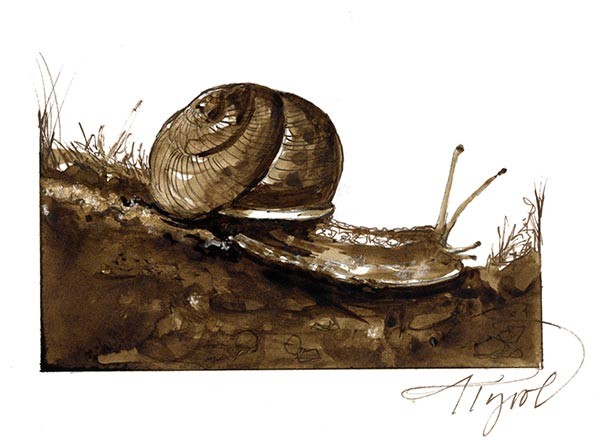
Once, hiking on the west coast, I picked up a big, bright yellow banana slug from the forest floor and brought it to my wife. She remembers that too – vividly.
Ok, ok, I know, snails and slugs have a high yuck factor. But take a moment and really watch one. You’ll see an intricately evolved creature of almost fluid grace.
Snails and slugs – basically a slug is a snail without a shell – are gastropods, meaning “belly-footed.” There are tens of thousands of species worldwide. And while there are no banana slugs in this part of the country, ninety-plus species of snails ooze across the fields and forests of northern New England.
“Snails are very graceful, sensual animals,” said Ken Hotopp, an expert on land snails of the eastern U.S. “They live in a world that’s mostly touch and smell. Those are their main senses. They don’t see very well. Our senses that are very refined are not the ones they depend on, so it’s hard to relate to their world.”
Most land snails have two pairs of tentacles. Their eyes are at the tip of their longer pair, noticeable as little black dots. They can’t focus their eyes, but they can make out patterns of light and dark. This limited vision allows them to tell when it’s night and day and to find shady spots, which, if you think about it, is crucial if you’re an animal that can get cooked by mere sunlight. (As a further protection against frying, snails are usually only active when it’s raining, or the humidity is over eighty percent.)
Much more acute is the snail’s sense of smell. All four of its tentacles are equipped with olfactory sensors. With these noses-on-stalks, snails can sample biochemical compounds in the air and on the ground. They can smell fungi from a distance, home in on a rotten log, smell other snails’ slime, and find their way back to a favorite resting spot.
Snails can swivel their tentacles independently, which is cool. They can also regrow them if they get bitten off, which is even cooler. And they can retract their tentacles, too, by turning them inside out like a sock. That might serve a cleaning function, Hotopp said, giving them a “fresh perspective on the chemical soup in the air” when they extend their tentacles again.
Most snail species in the Northeast are small, measured in millimeters, and found in high densities. Some eat live plants; others are decomposers, turning dead vegetation into humus. Some like tree sap. Still others scrape algae from tree bark. Some are less picky, happy to eat whatever is available.
Snails and slugs are touchy-feely creatures. In addition to their tentacles, they use their broad flat feet to feel their way through the world. Snails move at, well, a snail’s pace, the muscles in their feet contracting in a rhythm that propels them along. Their progress is aided by slime.
Snail slime is “a marvel of chemistry,” said Hotopp. And all slime is not the same. It varies in its chemical makeup, acidity, and thickness. Foot slime is thinner, allowing for a smooth flowing movement even over sharp objects, but it gets tacky when snails stop, enabling them to attach to a surface, even upside down. Snails sense when they’re upside down thanks to statocysts, little liquid-filled sacs with interior hairs that help them sense gravity. There are some substances snails won’t cross. Copper reacts with their slime and gives them a shock; the particles of diatomaceous earth are sharp and scrape their feet.
Slime protects snails from drying out and it has anti-fungal and anti-bacterial properties. A thick slime is exuded when snails feel threatened, which makes them distasteful to things that want to eat them. The defense slime of some species is visible under ultraviolet light, perhaps as a warning to predators that see in the ultraviolet portion of the spectrum. (Slime can also attract predators; some carnivorous snails, such as the gray-footed lancetooth, Haplotrema concavum, hunt other snails by following slime trails.)
The more one considers snails, the more impressive, and improbable their success as a life form is. “It’s just incredible to think how good they are at surviving with a very different set of adaptations than mammals,” said Hotopp. Slime, in particular, is a miracle substance, what Hotopp called a “fundamental adaptation,” which allows snails to thrive in a variety of environments, from moist forests to deserts and everywhere in between.
Hotopp’s favorite species is the whitelip snail, Neohelix albolabris, a common forest snail of New England. To find it, seek out woodlands with rotting wood on the ground. A half hour rummaging through the leaf litter should turn up this snail, he said.


Discussion *